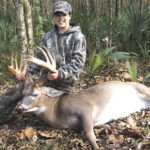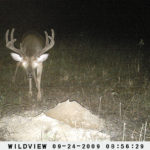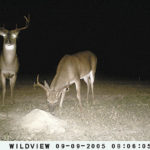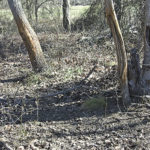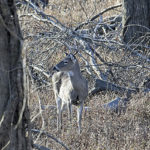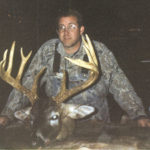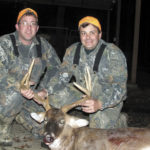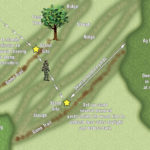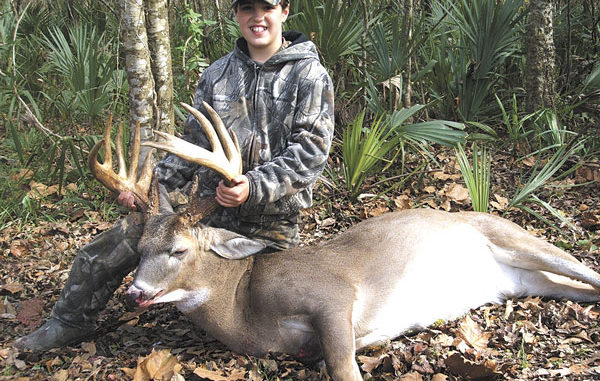
Deer generally are not the unpredictable animals many believe. Instead, they have set patterns, at least outside of the rut. Here’s a look at what bucks will be doing before they become love-crazed.
The buck had spent the dark hours of early morning munching in a wheat field, milling about with other deer and concentrating on filling its belly. There was only one short break while the animal tussled with a second buck in the moonlight, but it was more pushing around on the playground than a serious knife fight.
As the huge eyes of the gathered deer began registering the first hints of light, the animals filtered out of the field, slipping silently among the tall palmettos of the nearby hardwoods. The buck grabbed another bite or two of wheat and, with a buddy in tow, joined the exodus from the death trap of the open field.
Quickly, silently, the deer melted into the thick fronds. Soon the field was empty.
The man and boy huddled together a couple hundred yards inside the treeline, waiting in the cold predawn for the sun’s first rays to break darkness’ hold on the palmettoed forest.
Blake Charles had chosen the stand because he simply wanted 9-year-old Will Hollier to get a shot at a deer. It was almost a month before the rut, so he wasn’t tracking a big buck.
“I had seen eight does right there, so I knew those deer would be coming through there,” Charles said. “They were heading for the wheat fields that afternoon.”
Soon, faint light leaked over the horizon, and the forest began to awaken. Almost as soon as individual outlines of the palmetto fans below could be distinguished, the young Hollier nudged Charles.
The two deer slid through the understory, ducking beneath the fans of vegetation and barely making a sound. Only the occasional slight rustle of palmettos gave away the two brown ghosts.
In the lead was a real monster, carrying a heavy-limbed crown of calcium that had been polished on trees and bushes over the past month or so to remove the itchy, dying skin covering.
The dominant buck looked around as the woods continued to lighten, and it picked up the pace — still not fast enough to make much noise, but on a mission to make it back to the safety of the thick bedding area deep inside the woods before the sun rose too high.
The only obstacle was one relatively open area. Cross that, slip back into the palmettos and make the rest of the trip under the cover of the opaque leaves of the ground palms.
After pausing to ensure there were no threats, the buck stepped out and slowly walked the edge of the opening, eyes fixed on the safety awaiting only 60 yards away.
Young Hollier, whose mother wanted him back early to take care of homework, was freezing. He nudged Charles.
“Maybe we can stay a few more minutes and then go,” Hollier whispered.
Charles agreed, and they scanned the woods once more.
Movement caught Hollier’s attention as he looked among the palmettos, and all thoughts of the cold disappeared instantly as antlers flicked through openings.
“There’s a deer,” Hollier whispered, quietly patting his mentor. Nervous excitement could be heard in the quavering voice. “I think it’s a buck.”
Charles turned and saw the deer slipping along the edge of the thick growth. Even in the relative opening there were scattered palmettos that made it a challenge to get a fix on exactly how big the deer was.
However, it was clear it was a buck — a big buck.
“I knew he was a shooter,” Charles said. “There was no doubt.”
Another deer was tagging along some distance behind the big deer, but both hunters were transfixed by the lead buck. As it worked its way along the edge of the opening, the deer was walking almost directly toward the double ladder stand in which Hollier and Charles were sitting.
Then it stopped and lifted its head.
Something wasn’t right. There was the slightest movement in a nearby tree. The deer, which had been relaxed, lifted its head slightly and froze. It was immediately on alert, staring intently through the covering palmettos.
Nothing seemed out of place, but experience had taught the buck not to discount instinct.
There it was again, and the deer’s muscles tensed in preparation for a quick escape.
Charles was as excited as the youngster at his side, but he was worried the opportunity of a lifetime would be missed.
“I knew the deer was looking at us,” Charles said. “It was now or never.”
The problem was that the young hunter holding his gun on the deer had been taught to wait for the high-percentage broadside shot. And Hollier had learned this lesson a little too well.
“I said, ‘Pull the trigger,’” Charles said. “Will told me, ‘But it’s not broadside.’
“I told him, ‘’I know that, but if you don’t shoot he’s going to get away. Pull the trigger.’”
The .243 barked, and the buck whirled and disappeared into the palmettos.
Another minute movement, and the buck made its decision: Run.
As it bunched its muscles to turn into the thicker vegetation only a step away, a sharp pain pierced its chest. Almost at the same time, an explosion deafened the now frantic animal.
Instinct took over, and the buck wheeled into the palmettos and streaked away.
The accompanying deer was nowhere to be found as the wounded deer ran for the thickets, all thoughts of stealth discarded.
And then the adrenaline fueling the all-out run began to abate, and the deer slowed. It walked a few yards more, and then lay down. It was just too tired to continue.
The buck settled down for a quick rest, but soon found itself lying on its side kicking. Its eyes finally closed once more, and the woods faded away.
The two hunters struggled to control their breathing, and after an eternal 30 minutes, climbed down to track the buck. They found not a drop of blood.
Excitement quickly turned sour as a thorough search of the area failed to turn up any evidence that the bullet hit the buck.
“Let’s go back and get some help,” Charles suggested, but the young Hollier wasn’t ready to give up.
“Can we look down this deer trail before we go?” he asked.
Charles, unwilling to discourage Hollier, agreed.
The elder hunter took the lead and pushed through the thick palmetto fans, and soon Hollier heard a yell of victory.
The 11-point Charles found was a real bruiser, taping out at 168 7/8 inches Boone & Crockett. And Hollier was quickly swept up in an impromptu celebration.
“He screamed and picked me up, and we twirled around in circles,” Hollier recalled. “It’s a moment I’ll always remember.”
What is most amazing about the kill is it didn’t happen during the rut, when big bucks are least cautious and most likely to be caught moving around during the daytime.
Hollier’s story proves that, while most hunters think of the rut as being the best opportunity to take a nice buck, the animals don’t just appear once breeding season begins: They’re still in the woods and moving about.
It’s just a matter of understanding their motives and adjusting tactics to ambush them when they’re forced out of their hiding places.
Be sure to read Tracking the Rut, Part II, in the December 2009 issue. The series will conclude with Tracking the Rut, Part III, in the January 2010 issue.
